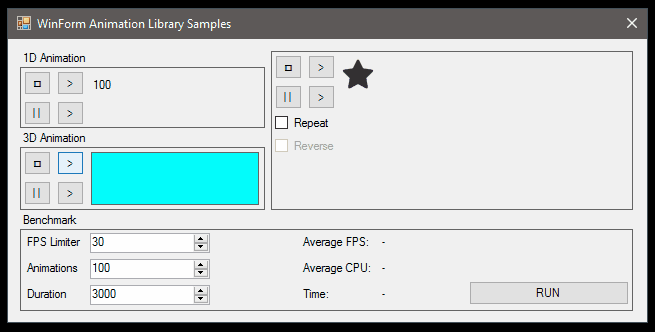A simple library for animating controls/values in .Net WinForm (.Net 3.5 and later). Key frame (Path) based and fully customizable.
Please note that even though this library designed for WinForm but its usage is not limited to WinForm and can be used in other environments. Only reference of the library is to 'System.Drawing' name space.
This library is available as a NuGet package at nuget.org.
Float2D: A class containing twofloatvalues as Vertical and Horizontal coordinates representing a point in a 2D plane.Float3D: A class containing threefloatvalues as Vertical, Horizontal and Depth coordinates representing a point in a 3D plane.Path: A class containing afloatstarting and afloatending point for a single dimensional animation as well as duration and the function to control the animation.Path2D: A class containing aFloat2Dstarting and aFloat2Dending point for a two dimensional animation as well as duration and the function to control the animation.Path3D: A class containing aFloat3Dstarting and aFloat3Dending point for a three dimensional animation as well as duration and the function to control the animation.Animator: A class for animating an array ofPathobjects. This class is one of the main classes and starting points of a basic animation.Animator2D: A class for animating an array ofPath2Dobjects. This class is one of the main classes and starting points of a basic animation.Animator2D: A class for animating an array ofPath3Dobjects. This class is one of the main classes and starting points of a basic animation.SafeInvoker: A class holding a reference to a function to invoke in the correct thread, detected by aControlobject passed to it. Useful for easier UI manipulations.SafeInvoker<T>: Same asSafeInvokerclass but with a generic argument for the function to invoke.
For full documentation of the classes and their members, please take a look at our doxygen page at falahati.github.io.
Following code animates a property named Value of a ProgressBar named pb_progress in 5 seconds from zero to one hundred:
new Animator(new Path(0, 100, 5000))
.Play(pb_progress, Animator.KnownProperties.Value);Following code animates a Form in two paths. First one moves the Form from (0, -100) to (100, 200) and second path waits for 3 seconds and then moved the Form to its initial location in 2 seconds. (this is a Form)
new Animator2D(
new Path2D(0, 100, -100, 200, 5000).ContinueTo(this.Location.ToFloat2D(), 2000, 3000))
.Play(this, Animator2D.KnownProperties.Location);Following code animates a property named CustomColor of a Control named c_customLabel in 2 seconds and after a delay of 1 second using the AnimationFunctions.CubicEaseIn function and with maximum of 10 frames per second.
new Animator3D(
new Path3D(Color.Blue.ToFloat3D(), Color.Red.ToFloat3D(), 2000, 1000, AnimationFunctions.CubicEaseIn),
FPSLimiterKnownValues.LimitTen)
.Play(c_customLabel, "CustomColor");There are extension methods for Path, Path2D, Path3D and their arrays to let you continue the path easily and define the key frames as fast as possible. For example, following code moves a Control named c_control in a rectangular path infinitely:
new Animator2D(
new Path2D(new Float2D(100, 100), new Float2D(200, 100), 1000)
.ContinueTo(new Float2D(200, 200), 1000)
.ContinueTo(new Float2D(100, 200), 1000)
.ContinueTo(new Float2D(100, 100), 1000))
{
Repeat = true
}.Play(c_control, Animator2D.KnownProperties.Location);It is possible to define a custom callback as frame handler as well as defining a call back to handle the end of the animation. Following example will call a method named CustomSetMethod for setting new values and handle the frames, and starts the animation in reverse path after its end for one more time:
var animator = new Animator(new Path(100, 200, 1000).ContinueTo(400, 500));
animator.Play(new SafeInvoker<float>(CustomSetMethod), new SafeInvoker(() =>
{
animator.Paths = animator.Paths.Select(path => path.Reverse()).Reverse().ToArray();
animator.Play(new SafeInvoker<float>(CustomSetMethod));
}));Check the 'WinFormAnimation.Samples' project for simple usage examples.

The MIT License (MIT)
Copyright (c) 2016 Soroush Falahati
Permission is hereby granted, free of charge, to any person obtaining a copy of this software and associated documentation files (the "Software"), to deal in the Software without restriction, including without limitation the rights to use, copy, modify, merge, publish, distribute, sublicense, and/or sell copies of the Software, and to permit persons to whom the Software is furnished to do so, subject to the following conditions:
The above copyright notice and this permission notice shall be included in all copies or substantial portions of the Software.
THE SOFTWARE IS PROVIDED "AS IS", WITHOUT WARRANTY OF ANY KIND, EXPRESS OR IMPLIED, INCLUDING BUT NOT LIMITED TO THE WARRANTIES OF MERCHANTABILITY, FITNESS FOR A PARTICULAR PURPOSE AND NONINFRINGEMENT. IN NO EVENT SHALL THE AUTHORS OR COPYRIGHT HOLDERS BE LIABLE FOR ANY CLAIM, DAMAGES OR OTHER LIABILITY, WHETHER IN AN ACTION OF CONTRACT, TORT OR OTHERWISE, ARISING FROM, OUT OF OR IN CONNECTION WITH THE SOFTWARE OR THE USE OR OTHER DEALINGS IN THE SOFTWARE.